
by Mary Caperton Morton Wednesday, December 9, 2015
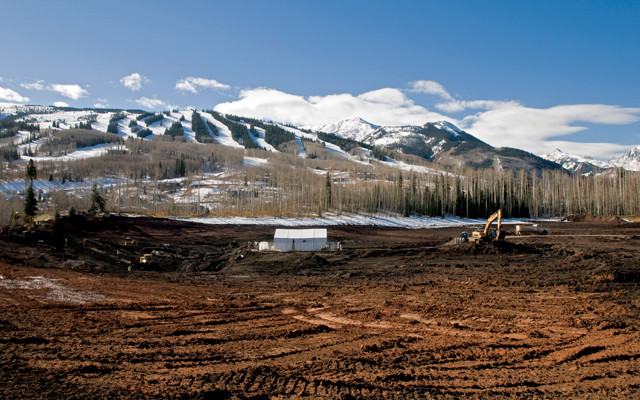
This site at Snowmass Village, Colo., is now submerged beneath a reservoir. But for a brief period in 2011, it was the site of one of the largest fossil excavations ever. In the end, scientists and volunteers collected 5,500 large bones and more than 30,000 small bones representing roughly 50 different species. Credit: ©Denver Museum of Nature & Science.
Snowmass Village, Colo., 270 kilometers west of Denver, is famous for being one of the premier ski destinations in the Rocky Mountains. But at the edge of the ski runs, under a man-made reservoir used for making snow, lie the ice-age stars of Snowmass Village: giant ground sloths, long-horned bison, North American camels, dozens of mammoths and mastodons and abundant insects and plant matter — basically an entire fossilized Pleistocene ecosystem. Imagining these extinct creatures roaming the lower-elevation grasslands and forests of North America is strange enough, but Snowmass Village sits at 2,705 meters of elevation, making this alpine site one of the highest Pleistocene fossil localities ever discovered.
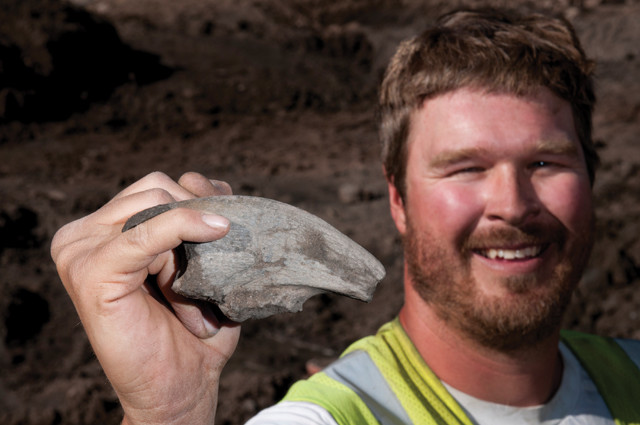
Ian Miller, chair of earth sciences at the Denver Museum of Nature & Science and co-leader of the Snowmastodon Project, holds a giant sloth claw. Credit: ©Denver Museum of Nature & Science.
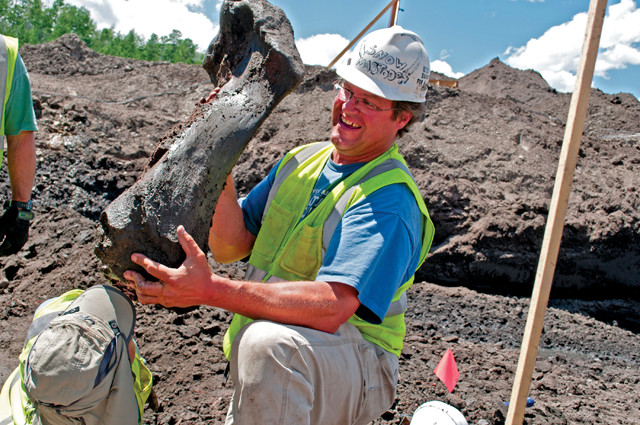
Kirk Johnson, former chief curator of the Denver Museum of Nature & Science, holds a large fossil bone up so that water in the fossil — "mastodon juice" — drains out into volunteer Chris Faison's mouth. Credit: ©Denver Museum of Nature & Science.
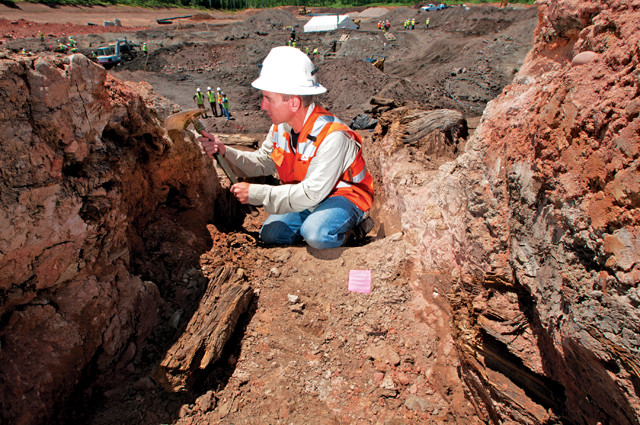
U.S. Geological Survey geologist Jeff Pigati helped excavate the site. Here, he examines soil layers among the driftwood on the "shoreline" of the Pleistocene lake. Credit: ©Denver Museum of Nature & Science.
Discovered in 2010 by construction workers during a planned expansion of the reservoir, the assemblage was quickly brought to the attention of scientists at the Denver Museum of Nature & Science. Because of its high-altitude setting, the ecosystem represented by the Snowmass Village assemblage had been subjected to rapid changes in temperature and climate, both warmer and colder than today, over the last several hundred thousand years. The sediments under the reservoir preserve a nearly continuous record of change from 140,000 to 55,000 years ago, including a span of time starting about 130,000 years ago as a glacial period began to wane.
“To find such an exquisite fossil site from this time period at this elevation is virtually unheard of,” says Ian Miller, chair of earth sciences and the paleobotanist at the Denver museum who was one of the leaders of the excavation at Snowmass Village, nicknamed the Snowmastodon Project. “It can tell us something about how ecosystems respond to climate change, which may tell us a lot about how plants and animals that live at significant altitude are going to respond to the global warming that’s happening today.”
“This project was unprecedented in its size, speed and depth of collaboration,” according to project co-leader and former Denver museum chief curator, Kirk Johnson, now director of the Smithsonian National Museum of Natural History in Washington, D.C. Scientists spent two weeks during fall 2010 and seven weeks in spring and summer 2011 excavating the ecosystem — collecting everything they could before the site was flooded to create a reservoir. The effort resulted in thousands of bones and all kinds of other fossils that scientists have been studying ever since.
Four years after the discovery, in November 2014, a suite of 14 papers written by 47 authors was published in a special Snowmastodon Project Science Volume of the journal Quaternary Research. “To be able to publish this number of papers with such tremendous scope in just four years is incredibly fast, especially for geologists,” says Jeff Pigati, a geologist with the U.S. Geological Survey in Denver, who helped excavate the site and who led the science on the project.
“The science volume now moves beyond the pure excitement of the discovery to the presentation of its hard science and its implications for understanding the biological and climate history of the Rocky Mountain region,” Johnson said in a statement released with the paper series.
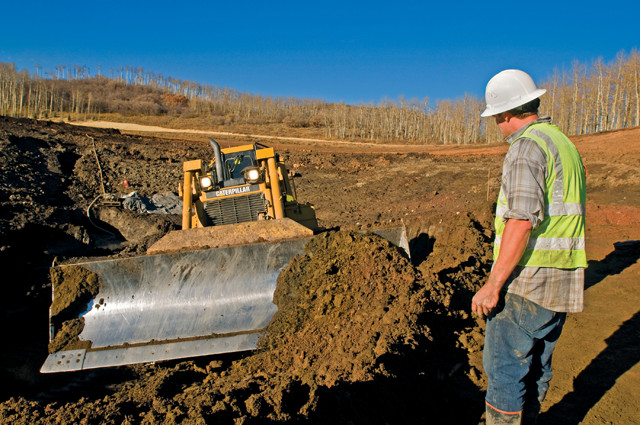
The Snowmastodon excavation involved the construction company overseeing the reservoir expansion, the Snowmass Water & Sanitation District, and museum scientists and volunteers. One excavation technique involved "bladerunners," like volunteer Dane Miller, walking alongside bulldozers to identify potential fossils and then alerting the bulldozer driver to stop if they saw something promising. Credit: ©Denver Museum of Nature & Science.
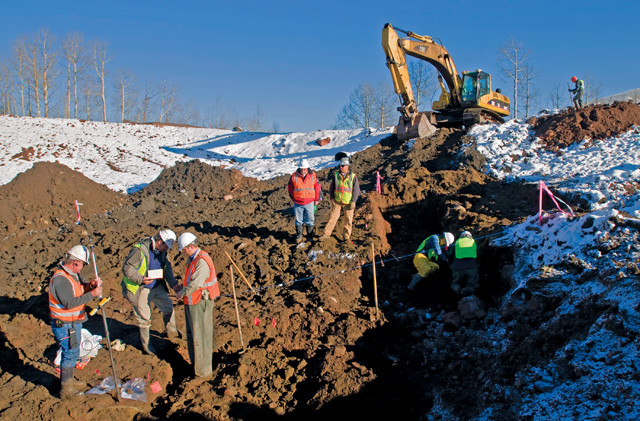
Researchers, volunteers and representatives of the Snowmass Water & Sanitation District work together to excavate the site. Credit: ©Denver Museum of Nature & Science.
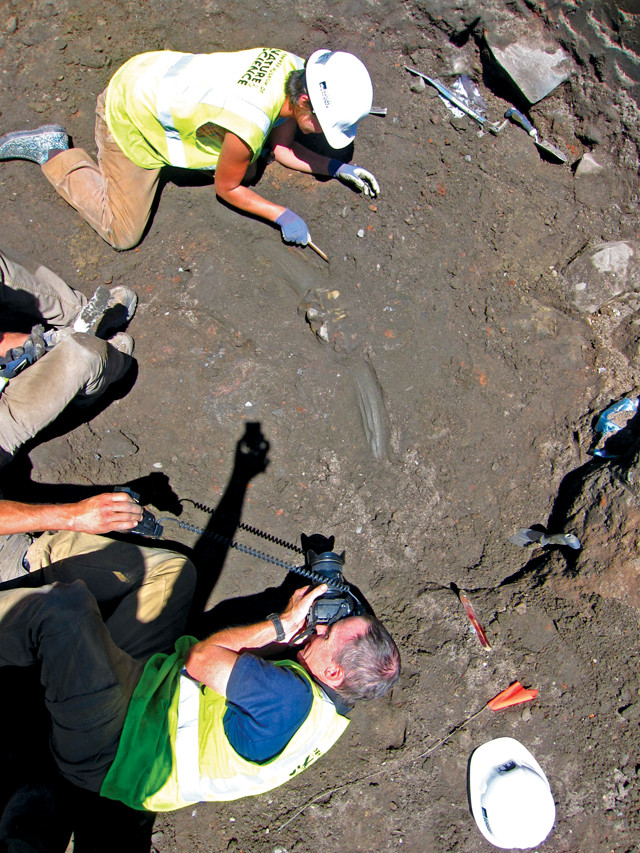
Photographers document the dig as researchers and volunteers excavate. Credit: Stephen Wagner.
The Snowmastodon site was discovered in October 2010 by a bulldozer driver working with the Snowmass Water & Sanitation District who was excavating the soft mud at the bottom of the Ziegler Reservoir just west of Snowmass Village. At the beginning of the dig, a surveyor had found a few large bones that were dismissed as cow bones. But when a set of massive ribs came up over the bulldozer’s blade, followed by a 20-centimeter-long tooth, and then a tusk, the crew began to suspect they had more than old cows on their site. A bit of online research by the excavation crew indicated the bones might have belonged to an ice-age mammoth, so they called the Denver museum.
A few days later, a team from the museum, led by Miller, made the 3.5-hour journey from Denver to investigate the find. While there, bulldozers turned up more bones indicating hat the reservoir had more than just one mammoth: The site was a veritable boneyard. Then, a mastodon tooth was unearthed, and scientists became even more excited: Mammoths and mastodons lived at the same time, but occupied different ecological niches, with mammoths living in grassy places and mastodons occupying forested settings, so the two proboscidea species are rarely found at the same fossil localities. “It quickly became evident that this was a sensational place,” Miller says.
The reservoir’s setting is unusual, situated as it is in a natural basin perched on top of a hill, like the dimple in the top of an apple. During the last glacial maximum about 20,000 years ago, long after the assemblage found at the site lived, ice flowed all around the hilltop lake, but not over top of it. Thus, the bones, buried in the lake sediments, were protected from the pulverizing forces of glacial ice, Miller says.
“High-elevation fossil sites are very rare and very sought after because they are the perfect setting for preserving a record of climate change; they are very sensitive to minor perturbations,” he says. The Snowmastodon site has given scientists an opportunity to study how a past ecosystem coped with warming climates. “This record of the most recent warm period [between about 130,000 and 115,000 years ago] gives us a great comparison to present day. If we turn up the thermostat just a little bit, what’s going to happen to these high-elevation ecosystems?”
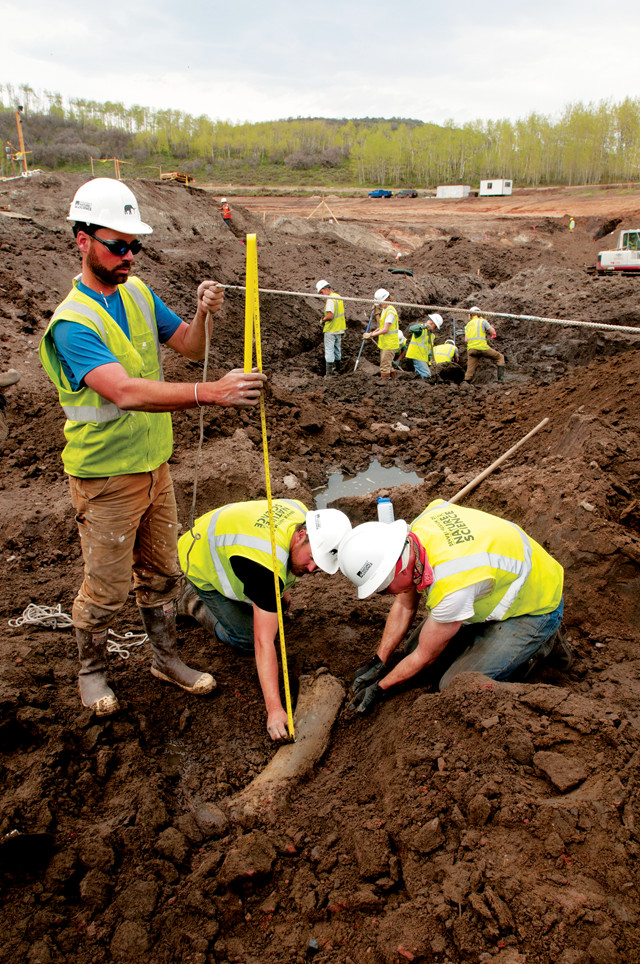
Joe Sertich, curator of vertebrate paleontology at the Denver Museum of Nature & Science, and two volunteers measure around a bone to create a three-dimensional map of the site. Credit: ©Denver Museum of Nature & Science.
Within a few weeks of the initial discoveries, the museum had a full team onsite, working alongside the bulldozer drivers to recover numerous bones. “At first, we used the ‘bladerunner’ technique, where somebody walks alongside the bulldozer and when they see a bone pop up they say stop,” Pigati says. “But then we got into areas of the site where there were so many bones, we couldn’t use the machines anymore. We had to do it all by hand. We ended up moving 6,000 cubic meters of material in the final six weeks. It took an army, many of them volunteers, to get the job done,” he says (see sidebar).
Some of the most important allies on the dig were the Snowmass Water and Sanitation District construction workers who originally uncovered what they thought were cow bones. “We worked side by side. They put a tremendous amount of time and money into unearthing these bones, they even gave us their heavy equipment to use,” Pigati says. “Every five minutes, an amazing bone came out of the ground. It was a joyous time, despite the wintry weather.”
Coordinating the army of scientists, construction workers and volunteers was no easy task, but the effort paid off. “It’s hard to convey the sheer chaos of the dig,” Pigati says. “But we came together as a team and developed a sampling strategy and a dating protocol so we could pull all the data together in the end.”
By the scheduled end of the dig in June 2011, the team had recovered 5,500 large bones and more than 30,000 small bones representing roughly 50 different species, including as many as 35 American mastodons, four Columbian mammoths, four ice-age bison, a Jefferson’s ground sloth and a camel, along with beavers, frogs, lizards, birds, rodents and snails. Numerous insects and large quantities of plant matter — so well preserved that some of the insects are still iridescent and some of the leaves are still green — were also found. All told, it is the most productive high-elevation Pleistocene fossil site ever discovered.

Credit: images: ©Denver Museum of Nature & Science; timeline: K. Cantner, AGI.
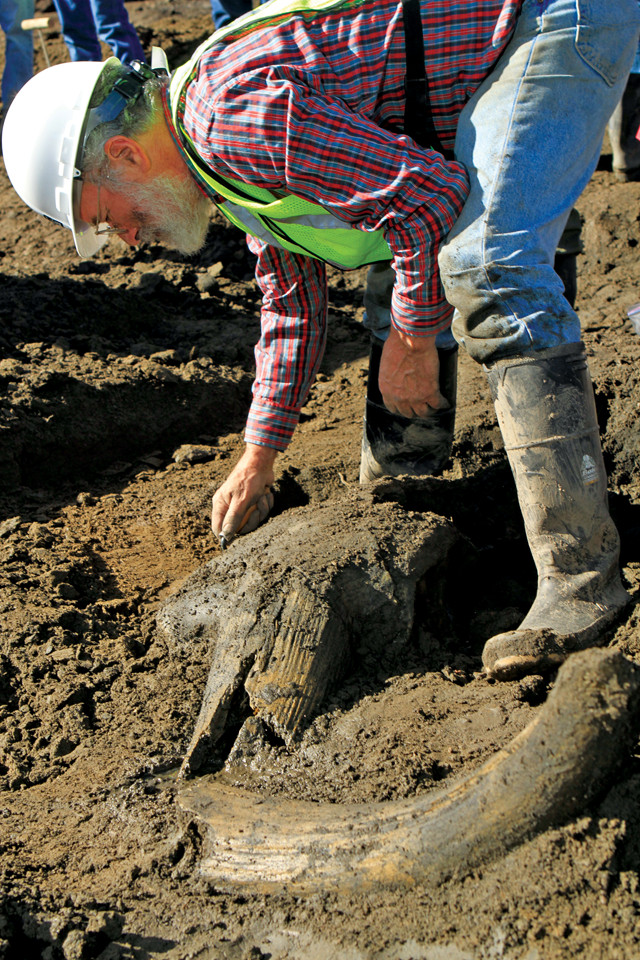
astodon expert Daniel Fisher of the University of Michigan digs out an extinct bison skull and horns. Credit: ©Denver Museum of Nature & Science.
Of all the fossils recovered from the Snowmastodon site, the 35 mastodons are the stars of the show. A number of mammoth sites have been discovered around North America, but quality mastodon sites are rare. And no site has ever produced the combination of mammoths and mastodons, or the sheer number or diversity of ages — from juveniles to adults — as the Snowmastodon site.
“Mammoths and mastodons look similar in a lot of ways — they’re members of the family Elephantidae — but they’re not closely related to each other,” Miller says. Mammoths were taller and more gracile, adapted to living in wide open grasslands; mastodons were bulkier, adapted to pushing their way through dense forests as they foraged on leaves and brush. “That we’ve found animals adapted to grasslands and animals adapted to forests speaks to the fact that the climate and ecosystem around this site changed drastically over time,” he says.
Telling mastodon fossils apart from mammoth fossils can be tricky, with some bones more readily distinguishable than others. “The molars are easiest to tell apart, since they ate very different types of food,” says Daniel Fisher, a paleontologist at the University of Michigan and one of the authors of some of the Quaternary Research studies. “The tusks are a little trickier but it’s usually possible to tell them apart by the overall shape.” Bones are harder still, he says, depending on the bone. “Some are obvious, due to the heavier build of the mastodon, while others are more mysterious.”
Careful excavation procedures enabled the team to recover the fossils from specific, dateable layers of sediment that helped them piece together the story of how the deposits were laid down over time. “As we understood the structure of the site more, it became clear that the mastodons and mammoths lived there at different times,” Fisher says. “Mastodons were there earlier, then the mammoths showed up.” Indeed, Miller adds, “we see the treeline go up and down past this site numerous times, as it changed from grasslands to forests and back again over time.”
The oldest layers the researchers dated were about 140,000 years old. At that time, much of Earth was still glaciated. By 130,000 years ago, temperatures warmed dramatically as the planet entered an interglacial period that lasted until 115,000 years ago. The Snowmastodon site was dominated by forests and mastodons during this time period and beyond, up until about 100,000 years ago. Between about 100,000 and 87,000 years ago, the site was cold — much more so than expected, Miller says. No animals, large or small, were found from this period. From about 87,000 to about 60,000 years ago, the site was dominated by grasslands and mammoths. Then toward the end of the sequence, which dates to about 55,000 years ago, a new glacial period had begun to set in.
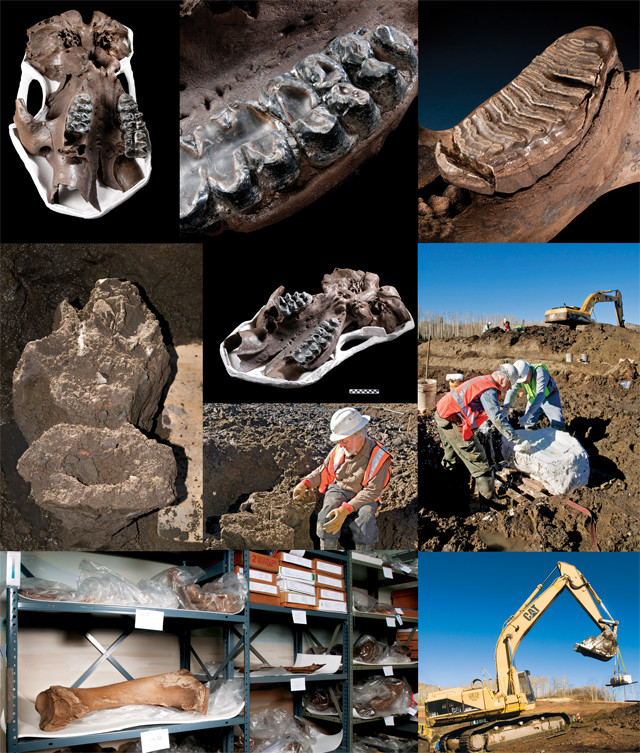
Top four images: Differentiating mammoths from mastodons is done by looking at their teeth: the left three sets are from mastodons and the upper right set is from a mammoth. The other images show the process of excavation: finding the fossils; painstakingly cleaning them off, as volunteer Don Brandborg demonstrates, then putting plaster jackets on them and using a crane to move them to a truck to carry them to the museum, where they're further cleaned and prepared. Credit: all: ©Denver Museum of Nature & Science.
Fisher and his colleagues focused on the mastodon fossils recovered from the site that dated to a time period between 140,000 and 100,000 years ago, when Earth experienced a warmer interglacial climate and began transitioning into the next glacial period. The presence of mastodons during this period indicates that the Snowmastodon site was likely more forested than later, when grasslands and mammoths took over the site. “This time period spans a major episode of climate change,” Fisher says. “We were really interested in studying how those animals dealt with climate change: How did they respond? How did their growth rates change? Were they better off cooler or warmer? Or did they cope all along?”
Like elephants, mastodons preserve records of their growth rates in their tusks, which grow a little longer and thicker each year. A study of the many mastodon tusks and fragments recovered at the site revealed that growth rates remained steady over time, even while parallel studies of insects, pollen and plant assemblages confirmed that the climate went through warm and cool periods.
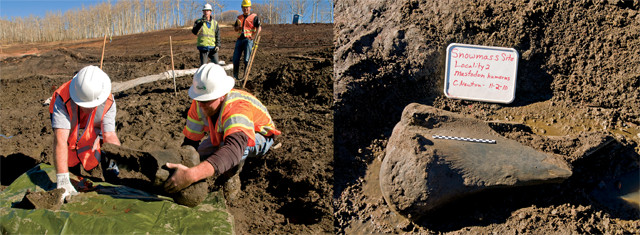
Volunteers catalog and then remove a mastodon humerus. Credit: both: ©Denver Museum of Nature & Science.
“It seems that, despite living through periods of significant climate change, the mastodons just kept chugging along, doing as well in the beginning of the sequence as they did in the end,” Fisher says. Climate change is thought to have played a role in the extinction of mastodons, mammoths and other large megafauna about 10,000 years ago, although many scientists lean toward overhunting and habitat pressure from humans as the main culprit. The Snowmastodon findings seem to lend support to the latter theory. “It seems that this [earlier] sequence of climate change didn’t knock them for much of a loop. They were actually very resilient animals,” he says.
While mammoths and mastodons are arguably the most exciting fossils found at Snowmass Village, other, smaller fossils of plants and insects can reveal a lot about the environment as well, says Dick Mol, a paleontologist at the Natural History Museum of Rotterdam in Germany who was not involved in the Snowmastodon Project. “This is a multidisciplinary project of great importance that gives us a better understanding of what the landscape looked like during this time period.” Mol says he is looking forward to hearing more about the Snowmastodon Project at the next International Conference on Mammoths and Their Relatives, to be held in 2017. Snowmastodon “is a very special site that preserves a more or less complete ecosystem, which can give us some insights into why some of these animals eventually went extinct,” Mol says.
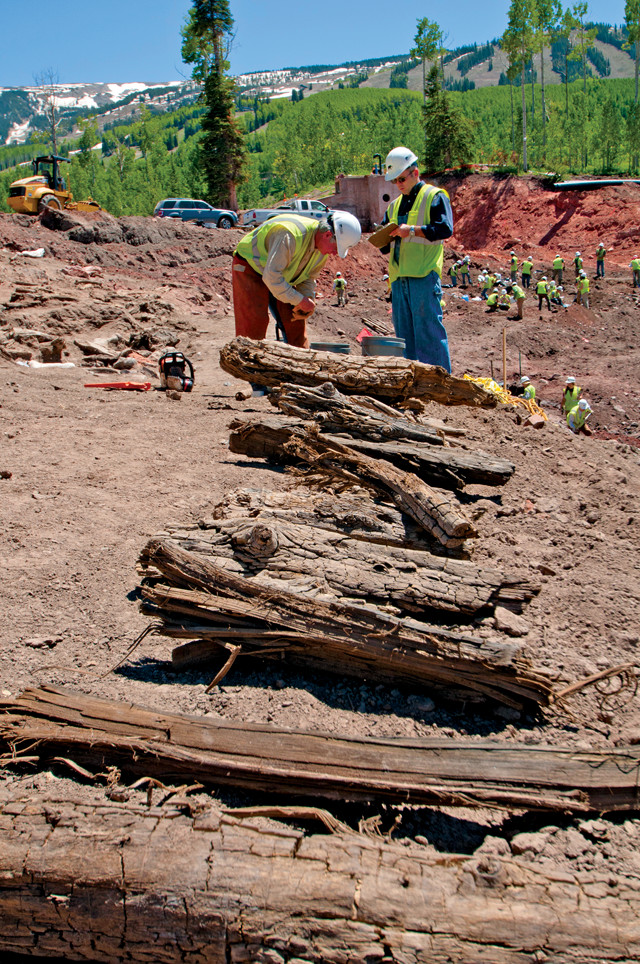
Peter Brown, a dendrochronologist at Rocky Mountain Tree-Ring Research, and Steve Nash, chair of the anthropology department at the Denver Museum of Nature & Science, examine ancient trees. Credit: ©Denver Museum of Nature & Science.
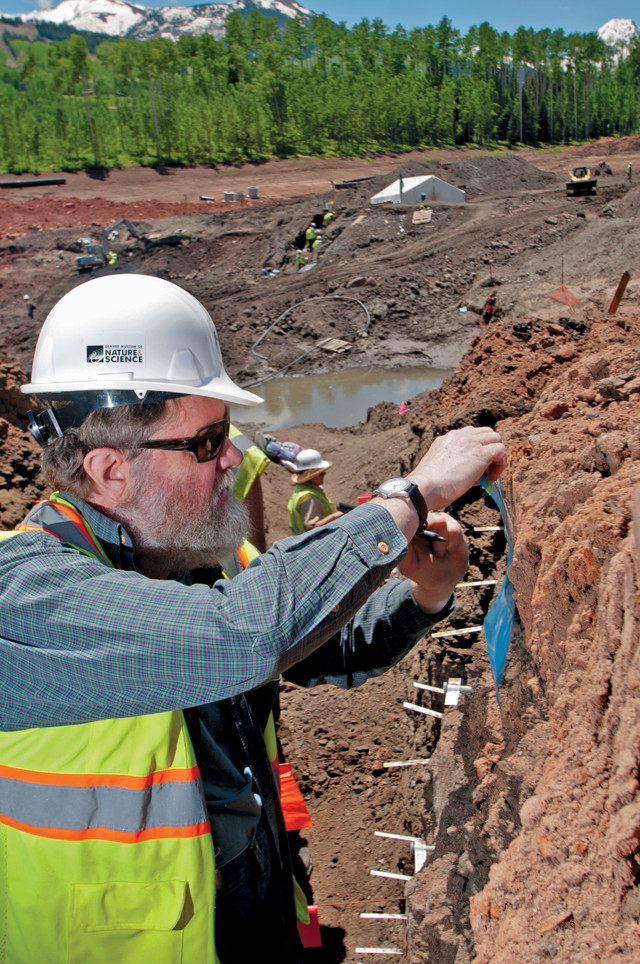
Scott Elias of Royal Holloway, University of London, looks for insect fossils. Credit: ©Denver Museum of Nature & Science.
Of all the fossils found at the Snowmastodon site, the vast majority of them are preserved insects and plants. “Of course, the big mammals get all the attention, but we identified four times as many insect species as vertebrate species. It’s an incredibly rich site for insects,” says Scott Elias, a Quaternary scientist at Royal Holloway, University of London, in England and lead author of one of the Quaternary Research studies. “It makes sense: If you look at any ecosystem, there will be more insects than anything else.”
The assemblage of insects from the warm intervals at the site was dominated by beetles. “Beetles tend to dominate because they can play so many roles. They can be terrestrial or aquatic, predators or plant eaters, and often specialize to fill very specific niches, like eating a certain type of animal’s dung,” Elias says.
Nearly 100 species of beetles have been identified to date at the Snowmastodon site. Some beetle species are known to closely associate with certain species of mammals, such as ground squirrels and marmots, indicating that many types of small mammals likely lived in the region, though their remains were not found. “I suspect that there was at least one species of beetle that specialized in eating mammoth dung, the way beetles in Africa specialize in elephant dung, but I haven’t found it yet,” Elias adds.
Most of the larger animals found at the Snowmastodon site are now extinct, but nearly all the species of insects and plants found there are still thriving today — albeit elsewhere. “One of the strange things about the Pleistocene extinctions is that we lost all these big animals, but the insects and plants lived through it,” Miller says. “That speaks to human interaction being the likely culprit that drove them to extinction, rather than climate change, which would have affected a greater diversity of plant and insect species.”
The insects found in the layers of sediment can provide additional clues about the past climate of the region, Elias says. Because most of the species they found are still living, scientists know the sorts of climates in which they thrive. Many of the species identified are now native to the Pacific Northwest, suggesting that the climate in the Colorado Rockies may have been warmer and wetter at times over the past 140,000 years than it is today.
Copious plant matter was also recovered from the Snowmastodon sediments, including 12-meter-long tree trunks, bits of 70,000-year-old plant matter that were still green when unearthed, and abundant pollen samples. Like with the insects, “we found a combination of plants that’s not seen in Colorado today,” Miller says.
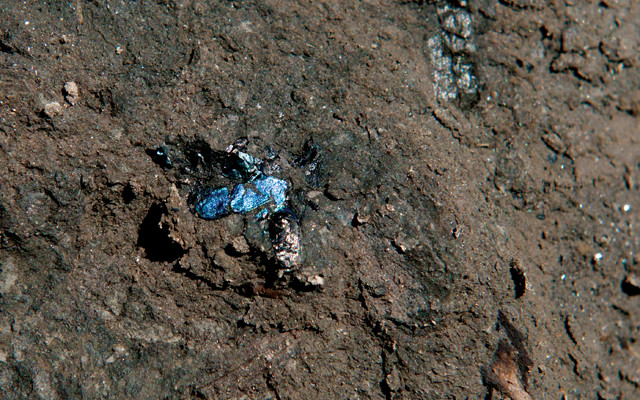
Numerous insects and large quan tities of plant matter — so well preserved that some insects are still iridescent — were found at the site in addition to the large mammals. Credit: ©Denver Museum of Nature & Science.
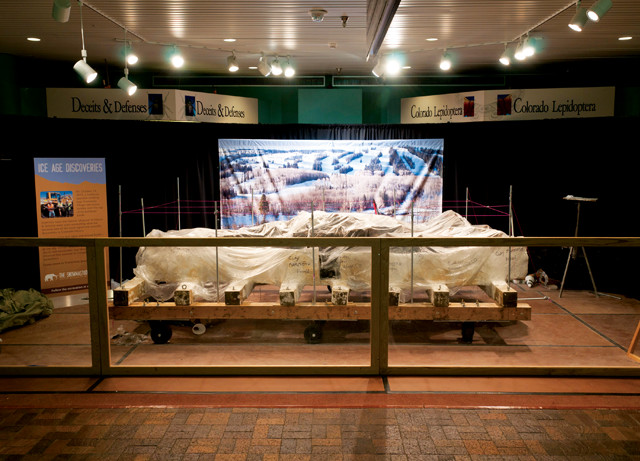
Mammoth bones in plaster were put on display at the Denver Museum of Nature & Science so visitors could watch how scientists extract the bones. Credit: ©Denver Museum of Nature & Science.
According to the layers of plants and pollen, the ecosystem changed drastically over the time span recorded, he says. Early on, the flora were adapted to “open tundra, with squat spruce trees [indicating] cold climates and heavy snows [140,000 years ago]. Then it warms up and you see giant trees” during the interglacial period about 120,000 years ago.
The trees, often recovered in the form of whole logs and branches, were identified as Douglas firs, and Englemann, blue and white spruces. At some point in the lake’s history, this combination was found at the site. Today, this combination of trees is no longer found in Colorado, only in Canada and Alaska, says Peter Brown, a dendrochronologist at Rocky Mountain Tree-Ring Research in Fort Collins, Colo., who authored one of the Quaternary Research studies. “We didn’t find any aspen at all, which is surprising given that it grows all over the region today.”
Research on the Pleistocene plants of Snowmass Village is ongoing, Brown says. Future work will include producing additional tree-ring chronologies to piece together a more complete climate record, as well as studying the chemical composition of the wood to shed more light on how climate change affects various isotope ratios preserved in the wood. “We have more than 300 chunks of wood,” he says. “It’s a lot more than we know what to do with at this point.”
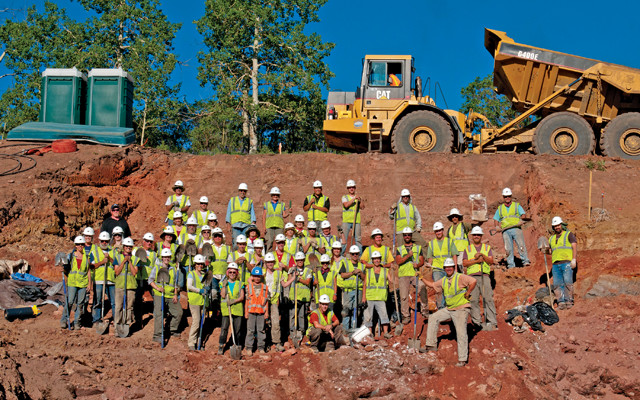
A volunteer army was needed to excavate this site in just seven weeks in spring and summer 2011. Credit: ©Denver Museum of Nature & Science.
The sheer number of fossils and species unearthed at Snowmastodon is impressive, but it represents only about 10 percent of the total assemblage, Miller says. “This is a 12-hectare lake and we only dug out about 1 hectare of dirt before our time was up and they needed to refill the reservoir,” he says. Miller and colleagues considered making a plea to the governor of Colorado to halt the reflooding of the reservoir so they could remove more fossils, but “by then, we had spent a ton of money and we were overwhelmed with fossils and we really needed to start the science part” of the effort, he says.
Although some people might bemoan leaving so many fascinating fossils in the ground, Miller points out that “it’s typical for scientists not to dig the entire resource out of the ground because you don’t know what you might glean from having it in situ in the future.” By leaving the fossils in place and reflooding the reservoir, they have effectively preserved them for years to come. “This is the perfect cold, low-oxygen environment for those fossils. And they’re quite safe from vandalism. Nobody’s going to disturb those fossils until we’re ready to go back for more.”
© 2008-2021. All rights reserved. Any copying, redistribution or retransmission of any of the contents of this service without the expressed written permission of the American Geosciences Institute is expressly prohibited. Click here for all copyright requests.